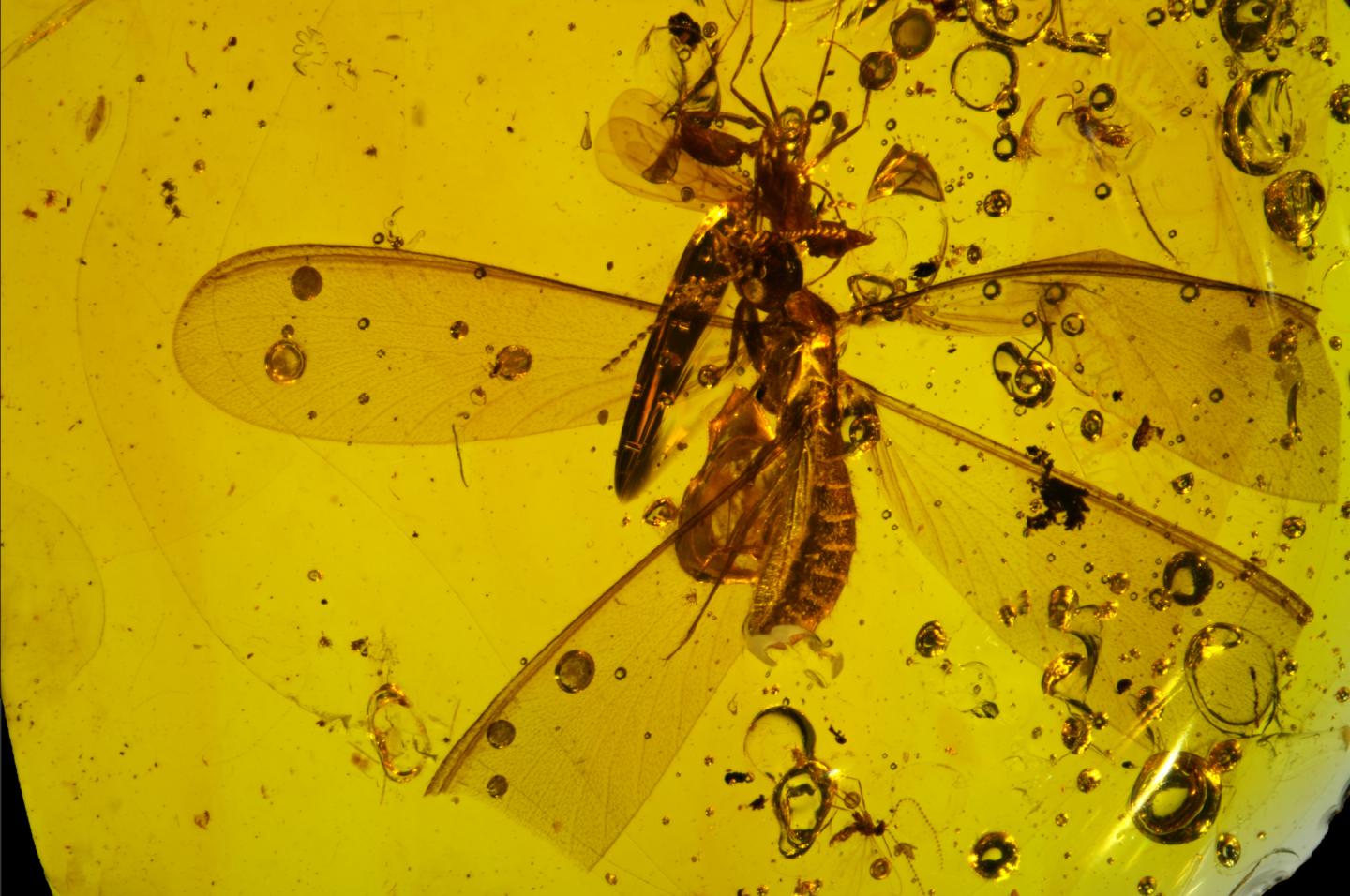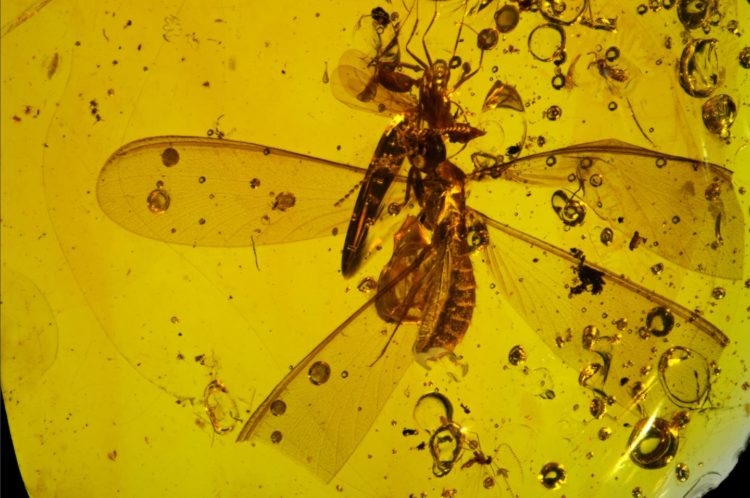
Credit: N. Robin, C. D’Haese and P. Barden
When trying to better the odds for survival, a major dilemma that many animals face is dispersal — being able to pick up and leave to occupy new lands, find fresh resources and mates, and avoid intraspecies competition in times of overpopulation.
For birds, butterflies and other winged creatures, covering long distances may be as easy as the breeze they travel on. But for soil-dwellers of the crawling variety, the hurdle remains: How do they reach new, far-off habitats?
For one group of tiny arthropods called springtails (Collembola), a recent fossil discovery now suggests their answer to this question has been to piggyback on the dispersal abilities of others, literally.
In findings published in BMC Evolutionary Biology, researchers at the New Jersey Institute of Technology (NJIT) and Museum national d’Histoire naturelle have detailed the discovery of an ancient interaction preserved in 16-million-year-old amber from the Dominican Republic: 25 springtails attached to, and nearby, a large winged termite and ant from the days of the early Miocene.
The fossil exhibits a number of springtails still attached to the wings and legs of their hosts, while others are preserved as if gradually floating away from their hosts within the amber. Researchers say the discovery highlights the existence of a new type of hitchhiking behavior among wingless soil-dwelling arthropods, and could be key to explaining how symphypleonan springtails successfully achieved dispersal worldwide.
“The existence of this hitchhiking behavior is especially exciting given the fact that modern springtails are rarely described as having any interspecfic association with surrounding animals,” said Ninon Robin, the paper’s first author whose postdoctoral research at NJIT’s Department of Biological Sciences was funded by the Fulbright Program of the French-American Commission. “This finding underscores how important fossils are for telling us about unsuspected ancient ecologies as well as still ongoing behaviors that were so far simply overlooked.”
Today, springtails are among the most common arthropods found in moist habitats around the world. Most springtails possess a specialized appendage under their abdomen they use to “spring” away in flee-like fashion to avoid predation. However this organ is not sufficient for traversing long distances, especially since most springtails are unable to survive long in dry areas.
The hitchhikers the researchers identified belong to a lineage of springtails found today on every continent, known as Symphypleona,which they say may have been “pre-adapted” to grasping on to other arthropods through prehensile antennae.
Because springtails would have encountered such winged termites and ants frequently due to their high abundance during the time of the preservation, these social insects may have been their preferred hosts for transportation.
“Symphypleonan springtails are unusual compared to other Collembola in that they have specialized antennae that are used in mating courtship,” said Phillip Barden, assistant professor of biology at NJIT and the study’s principal investigator. “This antennal anatomy may have provided an evolutionary pathway for grasping onto other arthropods. In this particular fossil, we see these specialized antennae wrapping around the wings and legs of both an ant and termite. Some winged ants and termites are known to travel significant distances, which would greatly aid in dispersal.”
Barden says that the discovery joins other reports from the Caribbean and Europe of fossil springtails attached to a beetle, a mayfly and a harvestman in amber, which together suggest that this behavior may still exist today.
Barden notes that evidence of springtail hitchhiking may not have been captured in such high numbers until now due to the rarity of such a fossilized interaction, as well as the nature of modern sampling methods for insects, which typically involves submersion in ethanol for preservation.
“Because it appears that springtails reflexively detach from their hosts when in danger, evidenced by the detached individuals in the amber, ethanol would effectively erase the link between hitchhiker and host,” said Barden. “Amber derives from fossilized sticky tree resin and is viscous enough that it would retain the interaction. … Meaning, sometimes you have to turn to 16-million-year-old amber fossils to find out what might be happening in your backyard.”
###
About New Jersey Institute of Technology:
One of only 32 polytechnic universities in the United States, New Jersey Institute of Technology (NJIT) prepares students to become leaders in the technology-dependent economy of the 21st century. NJIT’s multidisciplinary curriculum and computing-intensive approach to education provide technological proficiency, business acumen and leadership skills. NJIT is rated an “R1” research university by the Carnegie Classification®, which indicates the highest level of research activity. NJIT conducts approximately $170 million in research activity each year and has a $2.8 billion annual economic impact on the State of New Jersey. NJIT is ranked #1 nationally by Forbes for the upward economic mobility of its lowest-income students and is ranked 53rd out of more than 4,000 colleges and universities for the mid-career earnings of graduates, according to PayScale.com. NJIT also is ranked by U.S. News & World Report as one of the top 100 national universities.
Media Contact
Tanya Klein
[email protected]
973-596-3433
Original Source
https:/
Related Journal Article
http://dx.





